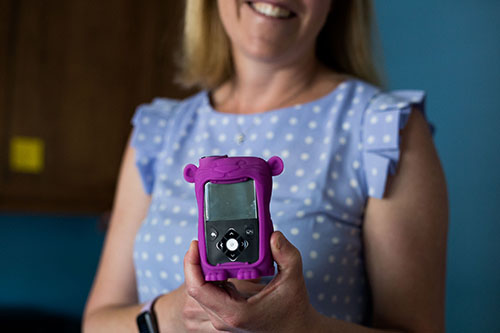How a question about cells could change lives
Study shows benefits of using ‘pump therapy’ as first-line diabetes treatment
Jennifer McVean, M.D., started to notice something that piqued her interest about a year after starting her young patients with new onset type 1 diabetes on automated insulin delivery systems from Medtronic – they seemed to be doing better than those who were using insulin shots with a standalone continuous glucose monitor (CGM).

The pediatric endocrinologist and Medical Affairs Sr. Director at Medtronic started to wonder, “What if automated insulin delivery systems prolong the ‘honeymoon phase’ of type 1 diabetes (T1D)?” – a time where the pancreas continues to make some of its own insulin.
In type 1 diabetes, the body attacks beta cells in the pancreas that make insulin. People with type 1 diabetes who continue to make their own insulin have fewer complications, and the disease is easier to manage. So, McVean thought, “what if we could preserve beta cells in children with new onset type 1 diabetes? Would that allow them to keep producing some insulin naturally for longer?”
She launched a proof-of-concept study using automated insulin delivery (AID) systems, including the MiniMed 780G insulin pump system. These AID systems include an insulin pump, a continuous glucose monitor, and an algorithm, or computer program, which automatically adjust the amounts of insulin delivered to help maximize the time glucose is within the recommended range. This helps minimize high and low blood sugars.
The study, sponsored by the JDRF, set out to answer McVean’s beta cell question. If children with diabetes could start automated insulin delivery (AID) treatment to increase their time in range within their first month of diagnosis, could beta cells survive longer? And if so, what could that mean for the future of diabetes care?
The study recently wrapped up, and was published in the Journal of the American Medical Association (JAMA). While it didn’t prove beta cells were surviving, it showed something else – improvement of Time in Range.
“That’s the benefit of starting a system up front,” McVean said. "There is a growing body of clinical evidence demonstrating the benefits of using automated insulin delivery systems as first-line treatment for type 1 diabetes over using continuous glucose monitoring as the only form of diabetes technology.”
The standard approach in the United States is to start patients on a CGM first. There’s been a significant spike in CGM adoption in recent years, with as much as a 10-fold increase in use among children.
But outcomes haven’t followed this upward trend. These results show we should consider starting automated insulin delivery systems shortly after diagnosis, McVean said.
Automated insulin delivery systems mimic some functions of a pancreas for balanced sugar levels throughout the day. The FDA recently approved the MiniMed™ 780G system with the Guardian™ 4 sensor, one of the systems used in McVean’s research. This is the first and only system with meal detection technology* to help account for when users occasionally forget to bolus or underestimates the number of carbs in their meal. AID technologies, like the MiniMed 780G system, take on some mental math associated with diabetes so kids and adults living with diabetes can focus on more than just their diabetes.
For McVean, the study shows the potential for children being diagnosed with diabetes to have a brighter future.

“If you have tight diabetes control from the beginning, you maximize your chances of living a long healthy life,” she said. “Automated insulin delivery changed my life, and I want that for everyone living with type 1 diabetes.”
Hear more about how we’re developing new innovative technology in the fight against diabetes.
Taking a bolus 15 – 20 min before a meal helps to keep blood sugar levels under control after eating.
Refers to auto correct, which provides bolus assistance. Can deliver all auto correction doses automatically without user interaction, feature can be turned on and off.
Refers to SmartGuard™ feature. Individual results may vary
The extended wear infusion set can be worn for up to 7 days. Current infusion sets are recommended for up to 3 days of wear
IMPORTANT SAFETY INFORMATION:
MINIMED™780G SYSTEM WITH SMARTGUARD™ TECHNOLOGY WITH GUARDIAN™ 4 SENSOR
The MiniMed™ 780G system is intended for continuous delivery of basal insulin at selectable rates, and the administration of insulin boluses at selectable amounts for the management of type 1 diabetes mellitus in persons seven years of age and older requiring insulin as well as for the continuous monitoring and trending of glucose levels in the fluid under the skin. The MiniMed™ 780Gsystem includes SmartGuard™ technology, which can be programmed to automatically adjust insulin delivery based on the continuous glucose monitoring (CGM) sensor glucose values and can suspend delivery of insulin when the sensor glucose (SG) value falls below or is predicted to fall below predefined threshold values.
The Medtronic MiniMed™ 780G system consists of the following devices: MiniMed™ 780G insulin pump, the Guardian™ 4 transmitter, the Guardian™ 4 sensor, One-press serter, the Accu-Chek™ Guide Link blood glucose meter, and the Accu-Chek™ Guide test strips. The system requires a prescription from a healthcare professional.
The Guardian™ 4 sensor is intended for use with the MiniMed™ 780G system and the Guardian 4 transmitter to monitor glucose levels for the management of diabetes. The sensor is intended for single use and requires a prescription. The Guardian™ 4 sensor is indicated for up to seven days of continuous use.
The Guardian™ 4 sensor is not intended to be used directly to make therapy adjustments while the MiniMed™ 780G is operating in manual mode. All therapy adjustments in manual mode should be based on measurements obtained using a blood glucose meter and not on values provided by the Guardian™ 4 sensor. The Guardian™ 4 sensor has been studied and is approved for use in patients ages 7 years and older and in the arm insertion site only. Do not use the
Guardian™ 4 sensor in the abdomen or other body sites including the buttocks, due to unknown or different performance that could result in hypoglycemia or hyperglycemia.
WARNING: Do not use the SmartGuard™ feature for people who require less than 8 units ormore than 250 units of total daily insulin per day. A total daily dose of at least 8 units, but no more than 250 units, is required to operate in the SmartGuard™ feature.
WARNING: Do not use the MiniMed™ 780G system until appropriate training has been received from a healthcare professional. Training is essential to ensure the safe use of the MiniMed™ 780G system.
WARNING: Do not use SG values to make treatment decisions, including delivering a bolus, while the pump is in Manual Mode. When the SmartGuard™ feature is active and you are no longer in Manual Mode, the pump uses an SG value, when available, to calculate a bolus amount. However, if your symptoms do not match the SG value, use a BG meter to confirm the SG value. Failure to confirm glucose levels when your symptoms do not match the SG value can result in the infusion of too much or too little insulin, which may cause hypoglycemia or hyperglycemia.
Pump therapy is not recommended for people whose vision or hearing does not allow for the recognition of pump signals, alerts, or alarms. The safety of the MiniMed™ 780G system has not been studied in pregnant women, persons with type 2 diabetes, or in persons using other anti-hyperglycemic therapies that do not include insulin. For complete details of the system, including product and important safety information such as indications, contraindications, warnings and precautions associated with system and its components, please consult https://www.medtronicdiabetes.com/important-safety-information#minimed-780g and the
appropriate user guide at https://www.medtronicdiabetes.com/download-library
Important Safety Information: Extended Wear Infusion Set (EIS)
The Extended Infusion Set is indicated for up to 7 days of wear for the subcutaneous infusion of insulin from an infusion pump. It is NOT indicated for intravenous (IV) infusion or the infusion of blood or blood products. Inaccurate medication delivery, infection and/or site irritation may result from improper insertion and maintenance of the infusion site. Before insertion, clean the insertion site with isopropyl alcohol. Remove the needle guard before inserting the infusion set. If using this infusion set for the first time, do the first set-up in the presence of your healthcare professional. Do not leave air in the infusion set. Prime completely. Check frequently to make sure the soft cannula remains firmly in place as you may not feel pain if it pulls out. The soft cannula must always be completely inserted to receive the full amount of medication. If the infusion site becomes inflamed, replace the set, and use a new site until the first site has healed. Replace the infusion set if the tape becomes loose, or if the soft cannula becomes fully or partially dislodged from the skin. Regularly replace the infusion set as indicated in the instructions for use, or per the insulin labeling, whichever duration is shorter. For more details, see https://
www.medtronicdiabetes.com/important-safety-information.
L001-07142023
Related content



